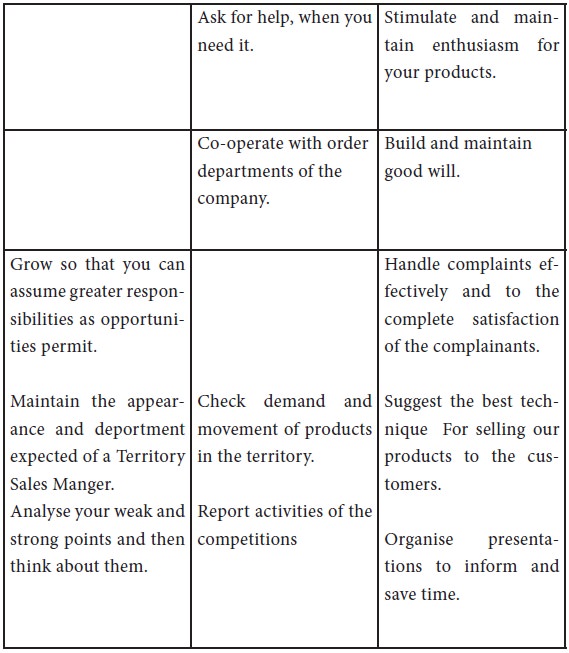Home | ARTS | Marketing Management
|
STEPS IN DESIGNING AND MANAGING A SALES FORCE - Sales Force Decision
MARKETING MANAGEMENT - PROMOTION DECISION
STEPS IN DESIGNING AND MANAGING A SALES FORCE - Sales Force Decision
Posted On :
Sales force is regularly assigned particulars territories. Various factors are taken into account in deciding on the physical size of a territory, transportation links within territory, purchasing power of consumers and their educational and living standards.
STEPS IN DESIGNING AND MANAGING A SALES FORCE
1. Setting of Objectives
2. Training for Sales Policies
3. Designing Sales Force Structure and Size
4. Deciding Sales Force Compensation
5. Recruiting and Motivating Sales Force
6. Guiding and Motivating Sales Force
7. Performance Rating of Sales Force
Sales force is regularly assigned particulars territories. Various factors are taken into account in deciding on the physical size of a territory, transportation links within territory, purchasing power of consumers and their educational and living standards.
Therefore, a sales force is deployed according to the geographical and product or consumer requirements. A company should also devote considerable effort in training and development of its sales force. There are two types of training which can be provided to sales force : (a) In –house training, and (b) on –the-job training. It is also necessary for a company to arrange periodic meetings and discussions with its Sales Force. Finally, the performance can be evaluated on the basis of targets and actual.
The Sales Manager is the most important person in a Sales organization. All Activities are based on his functions and responsibilities.
The following are some of the prime duties of a Sales Manager.
1. Organising sales research, product research, etc.
2. Getting the best output from the sales force under him.
3. Setting and controlling the targets, territories, sales expenses, distribution expenses etc.
4. Advising the company on various media, Sales promotion schemes, etc.
5. Monitoring the company’s sales policies.
Reid gives the following chart of the steps necessary for getting success in selling :


1. Setting of Objectives
2. Training for Sales Policies
3. Designing Sales Force Structure and Size
4. Deciding Sales Force Compensation
5. Recruiting and Motivating Sales Force
6. Guiding and Motivating Sales Force
7. Performance Rating of Sales Force
Organising and Managing a Sales Force
Sales force is regularly assigned particulars territories. Various factors are taken into account in deciding on the physical size of a territory, transportation links within territory, purchasing power of consumers and their educational and living standards.
Therefore, a sales force is deployed according to the geographical and product or consumer requirements. A company should also devote considerable effort in training and development of its sales force. There are two types of training which can be provided to sales force : (a) In –house training, and (b) on –the-job training. It is also necessary for a company to arrange periodic meetings and discussions with its Sales Force. Finally, the performance can be evaluated on the basis of targets and actual.
Sales Manager’s Duties and Responsibilities
The Sales Manager is the most important person in a Sales organization. All Activities are based on his functions and responsibilities.
The following are some of the prime duties of a Sales Manager.
1. Organising sales research, product research, etc.
2. Getting the best output from the sales force under him.
3. Setting and controlling the targets, territories, sales expenses, distribution expenses etc.
4. Advising the company on various media, Sales promotion schemes, etc.
5. Monitoring the company’s sales policies.
Reid gives the following chart of the steps necessary for getting success in selling :


Source : Reid, A.L., Modern Applied Salesmanship 1971, p. 418
Tags : MARKETING MANAGEMENT - PROMOTION DECISION
Last 30 days 661 views












